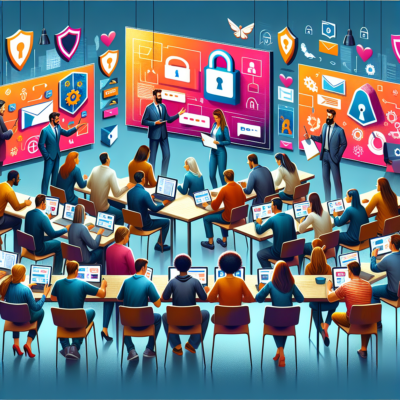Imagine this: It's a typical Tuesday morning, the office hums with the usual business of the day, and somewhere in the marketing department, an unsuspecting employee opens an email that appears to be from the CEO. The email asks for an urgent fund transfer to a new vendor. With deadlines looming and no time for second thoughts, the employee rushes to comply. What follows is a devastating realization that the organization has just fallen victim to a phishing scam.
This scenario isn't a rarity. In fact, it's becoming alarmingly common in today's interconnected business landscape. According to a 2022 report from the FBI, over 300,000 businesses in the United States fell victim to phishing alone. Those businesses lost over $52 million to phishing attacks alone.[1] These breaches aren't just costly—they're wake-up calls.
Enter the OECD Guidelines for the Security of Information Systems and Networks: an essential framework outlining how organizations can enhance their cybersecurity posture. The heart of the guidelines revolves around one crucial truth: "Awareness of the risks and available safeguards is the first line of defence for the security of information systems and networks."[2] This isn't just a line from a report; it's a fundamental principle that can transform how businesses approach cybersecurity.
As IT leaders, CISOs, and cybersecurity professionals, the task before us is clear:
- Cultivate a robust culture of cybersecurity.
- Implement the latest security technologies.
- Embed secure behaviors and mindsets into the very fabric of our organizations.
A culture shift is imperative to counter the ever-evolving threat landscape that targets our most valuable asset—our people.
The Need for a Culture of Security
The sheer volume and sophistication of today's cyber threats highlight the need for a fundamental cultural shift within organizations towards cybersecurity awareness. This shift moves beyond traditional IT measures, embedding security consciousness into every level of the organization.
Building Awareness and Education
Think of cybersecurity awareness as the foundation of a sturdy house. Without a solid base, even the most elaborate structures are doomed to collapse. Just as you'd inspect every brick, beam, and joint in a house, building a culture of security starts with educating and making everyone aware of the smallest cracks and vulnerabilities.
Types of Threats
Imagine running a marathon with a blindfold on—dangerous and bound to end in disaster, right? Similarly, employees navigating the digital landscape without understanding the threats they face are just as vulnerable. By providing knowledge about different types of cybersecurity threats—phishing attacks, malware, ransomware, insider threats—you essentially lift the blindfold.
I remember the first phishing simulation we ran at a financial firm I was consulting for. The results were eye-opening. Despite years of technical training, nearly half the employees clicked on a clearly fraudulent link. Suddenly, theoretical risks became personal. We conducted targeted training sessions immediately after, helping employees recognize red flags like suspicious email addresses and unexpected attachments.
Effective Training Methods
 Now, awareness is one thing, but how do you ensure this knowledge sticks? Picture cybersecurity training as planting seeds in a garden. It's a process that requires regular care and attention. If you sow the seeds (initial training) and never water them (ongoing education), you'll end up with a parched field of forgotten lessons.
Now, awareness is one thing, but how do you ensure this knowledge sticks? Picture cybersecurity training as planting seeds in a garden. It's a process that requires regular care and attention. If you sow the seeds (initial training) and never water them (ongoing education), you'll end up with a parched field of forgotten lessons.
- Real-life examples and case studies can be powerful. In one campaign, we highlighted how a small healthcare provider avoided a near-catastrophic breach thanks to an employee who reported a suspicious email. Sharing these success stories makes people realize that their actions matter.
- Interactive methods work wonders. Simulated phishing campaigns, like the ones we run at LinkSec, serve as 'practice runs' for real threats. Including quizzes and gamified training modules turns learning into an engaging activity rather than a monotonous chore. Remember, engaged employees are alert employees.
Responsibility of All Participants
Let's switch gears and think of a cybersecurity team as an orchestra. In this ensemble, every instrument—from the violin to the tuba—needs to play its part harmoniously to create a beautiful symphony. Similarly, in effective cybersecurity, every participant within an organization must understand and fulfill their role.
Collective Responsibility Model
During a consultancy project at a midsize tech firm, we instilled this idea of ‘cyber hygiene’ as a shared responsibility. Much like personal hygiene habits that keep you healthy, basic cybersecurity practices (like using password managers and not sharing confidential information) can significantly improve an organization’s overall security posture.
Individual Roles
-
C-suite and CISOs: Leadership in cybersecurity means more than approving a budget for the latest firewall. It means championing a culture of security from the top down. Leaders need to walk the talk, demonstrating best practices and fostering an environment where employees feel both responsible and empowered.
- Cybersecurity teams: Security professionals must no longer serve as simple gatekeepers. They must become a force-multiplier for translating complex threats into actionable insights and ongoing training for employees.
-
Everyone else: From interns to external contractors—everyone must remain vigilant, apply learned best practices, and report anomalies promptly. This collaborative effort ensures that every individual plays a vital role in safeguarding the organization's digital assets, creating a cohesive and resilient front against cyber threats. It’s truly an all-hands-on-deck approach to cybersecurity.
Whatever your role, it's crucial to recognize that cybersecurity is a shared mission. Just as a single discordant note can ruin an entire musical piece, one lapse in security can have widespread repercussions. In the cyber orchestra, we’re all essential players.
[1] - https://www.ic3.gov/Media/PDF/AnnualReport/2022_IC3Report.pdf
[2] - https://www.enisa.europa.eu/topics/risk-management/current-risk/laws-regulation/corporate-governance/oecd-guidelines


